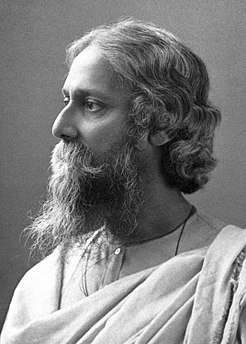Chokher Bali (novel)
| Author | Rabindranath Tagore |
|---|---|
| Translator | Krishna Kripalani |
| Country | India |
| Language | Bengali |
| Genre | Novel |
| Published | Serialised 1902-3; book form 1903 |
Published in English | 1959 |
| Media type |
Chokher Bali is a 1903 Bengali novel by Rabindranath Tagore that depicts the life of the central character, Binodini, and her relationships with three individuals. It explores the extramarital affair between Binodini, a young widow, and Mahendra, one of the three other main characters, the complicated friendship with Asha, his girl-wife, and her mutually conflicting feelings with Behari, Mahendra's adopted brother. The content also highlighted issues of women literacy, child marriage, gendered power hierarchy within the family and the fates of three widows[1]
Title
The title of the book can be translated as "a grain of sand", a "constant irritant to the eye", or an "eyesore". "Eyesore" was used as the title for its first English translation by Surendranath Tagore published in 1914. Tagore had used a working title Binodini before its publication.[2]
Writing and publication history
Tagore prepared himself for writing the novel by writing a spree of short stories and it was his first serious effort at a novel.[3] He began working on the novel in 1898 or 1899, and a draft version was completed in 1901.[2]
It was first serialized from 1902 to 1903 in the periodical Bangadarshan, then published as a full book in 1903. Some passages were deleted in the initial serialization and publication, but partly restored in the anthology Rabindra Rachanabali published in 1941, with more restored in an independent edition in 1947.[2][4]
Translation and adaptations
Chokher Bali, translated into English by Krishna Kripalani, was published under the title of Binodini in 1959 by the Sahitya Akademi. It was also translated into other non-Indian languages including Russian (1959) and Chinese (1961); and into most of the Indian languages including Hindi, Gujarati, Kannada, Malayalam, Marathi, Punjabi, Sindhi, Tamil, Telugu and Urdu. A transliteration in Devnagari script, with footnotes in Hindi, was also published by the Sahitya Akademi in 1961.[5]
Chokher Bali has been adapted a number of times in film, television and theatre. A stage adaptation was first performed in 1904,[2] and other versions were produced on screen and television, for example, Chokher Bali by Rituparno Ghosh in 2003, and in the television series Stories by Rabindranath Tagore in 2015.
References
- ↑ Kemwal, Ashmita. "Portrayal of Women Characters in Chokher Bali and Chaturanga".
- 1 2 3 4 Rabindranath Tagore, Radha Chakravarty. "Introduction". Chokher Bali. Random House India. ISBN 9788184003635.
- ↑ Roy, Nilanjana S. (28 October 2003). "Chokher Bali: A reader's progress" – via Business Standard.
- ↑ "Rabindranath Tagore's Norm-Defying Novel, Chokher Bali". Owlcation. 6 June 2017.
- ↑ Indra Nath Chaudhuri (2009). Encyclopaedia of Indian Literature: A-CYC. I (2nd ed.). Sahitya Akademi. p. 1043. ISBN 978-81-260-2384-4.
